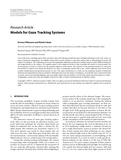Mostrar el registro sencillo del ítem
Models for gaze tracking systems
| dc.creator | Villanueva Larre, Arantxa | es_ES |
| dc.creator | Cabeza Laguna, Rafael | es_ES |
| dc.date.accessioned | 2015-09-30T07:35:27Z | |
| dc.date.available | 2015-09-30T07:35:27Z | |
| dc.date.issued | 2007 | |
| dc.identifier.issn | 1687-5176 | |
| dc.identifier.uri | https://hdl.handle.net/2454/18331 | |
| dc.description.abstract | One of the most confusing aspects that one meets when introducing oneself into gaze tracking technology is the wide variety, in terms of hardware equipment, of available systems that provide solutions to the same matter, that is, determining the point the subject is looking at. The calibration process permits generally adjusting nonintrusive trackers based on quite different hardware and image features to the subject. The negative aspect of this simple procedure is that it permits the system to work properly but at the expense of a lack of control over the intrinsic behavior of the tracker. The objective of the presented article is to overcome this obstacle to explore more deeply the elements of a video-oculographic system, that is, eye, camera, lighting, and so forth, from a purely mathematical and geometrical point of view. The main contribution is to find out the minimum number of hardware elements and image features that are needed to determine the point the subject is looking at. A model has been constructed based on pupil contour and multiple lighting, and successfully tested with real subjects. On the other hand, theoretical aspects of video-oculographic systems have been thoroughly reviewed in order to build a theoretical basis for further studies. | en |
| dc.format.mimetype | application/pdf | en |
| dc.language.iso | eng | en |
| dc.publisher | Hindawi Publishing Corporation | en |
| dc.relation.ispartof | EURASIP Journal on Image and Video Processing 2007, 2007:023570 | en |
| dc.relation.ispartofseries | Image and video processing for disability | en |
| dc.rights | © 2007 Villanueva and Cabeza. This is an open access article distributed under the Creative Commons Attribution License, which permits unrestricted use, distribution, and reproduction in any medium, provided the original work is properly cited. | en |
| dc.rights.uri | http://creativecommons.org/licenses/by/2.0/ | |
| dc.subject | Gaze tracking | en |
| dc.title | Models for gaze tracking systems | en |
| dc.type | info:eu-repo/semantics/article | en |
| dc.type | Artículo / Artikulua | es |
| dc.contributor.department | Ingeniería Eléctrica y Electrónica | es_ES |
| dc.contributor.department | Ingeniaritza Elektrikoa eta Elektronikoa | eu |
| dc.rights.accessRights | info:eu-repo/semantics/openAccess | en |
| dc.rights.accessRights | Acceso abierto / Sarbide irekia | es |
| dc.identifier.doi | 10.1155/2007/23570 | |
| dc.relation.publisherversion | https://dx.doi.org/10.1155/2007/23570 | |
| dc.type.version | info:eu-repo/semantics/acceptedVersion | en |
| dc.type.version | Versión aceptada / Onetsi den bertsioa | es |



